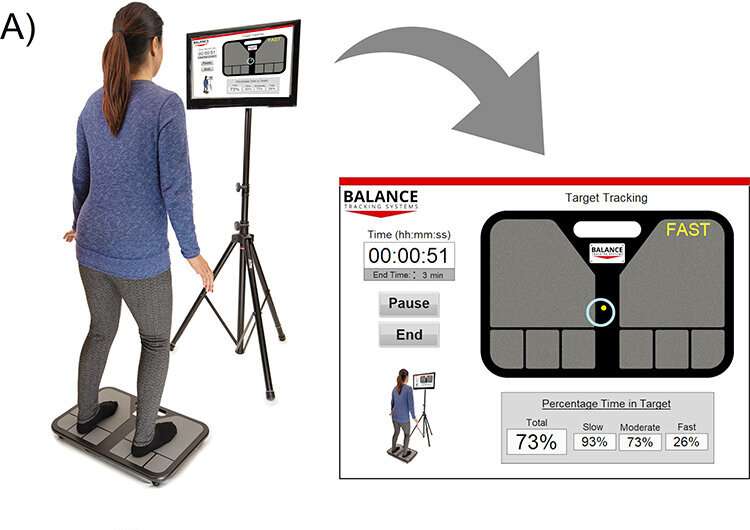This article has been reviewed according to Science X's editorial process and policies. Editors have highlighted the following attributes while ensuring the content's credibility:
fact-checked
trusted source
proofread
Training protocol improves balance by almost 30%

Good balance is a critical aspect of everyday life. From performing simple day-to-day activities like walking and climbing stairs to more complex, athletic activities, balance is required in order to prevent falls and injuries.
Seeing the need for more accessible and affordable methods of balance measuring and training, Dr. Daniel Goble, Oakland University director and associate professor of exercise science, created the Balance Tracking System, or BTrackS for short.
"BTrackS is medical device that senses the forces you create when standing on it to track body sway, which we know is an indicator of balance ability," Goble said.
BTrackS technology consists of a force platform that, when combined with the Assess Balance software, can be used in the health care industry to assess fall risk, vestibular disorders, neuropathy, traumatic brain injuries and more.
BTrackS is used worldwide and has revolutionized balance testing and training. Dr. Goble recently published a study examining the impact of a new BTrackS balance training protocol on healthy young adults.
In the study, participants first completed an assessment of dynamic balance by standing on the force plate and leaning as far as possible in all directions, providing a baseline assessment. After this, the participants did BTrackS' Target Tracking Training (TTT), where the objective is to keep a dot representing their center of balance in a moving target by shifting their center of pressure, which represents center of mass and body posture.
The exercise was done for only three minutes a day, five days a week, for six weeks—a total of just 90 minutes of training.
Upon finishing the six weeks of training, participants once again completed the assessment of dynamic balance. Results showed an average of a 29% improvement in balance. Furthermore, when the participants stopped training and the assessment was completed six weeks later, the gains of the training were still present.
The BTrackS TTT protocol requires much less of a time commitment than other methods of balance training, and is also fully portable, with participants doing the training in the comfort of their own home.
While the study shows balance improvements in healthy young adults, it is also anticipated that there would be significant improvement in those who struggle with balance, thus also decreasing fall risk and injuries associated with falls.
"Having a protocol available that positively impacts balance function with only a modest time commitment has tremendous potential for benefiting those individuals seeking balance improvements," Goble said.
The study was published in Medical Devices: Evidence and Research.
More information: Nathan O Conner et al, Six Weeks of at Home BTrackS Target Tracking Training Induces Sustained Dynamic Balance Improvement in Healthy Young Adults, Medical Devices: Evidence and Research (2023). DOI: 10.2147/MDER.S404536



















